Editing MP3 Files Using Music Maker
– Here's How!
Would you like to edit an MP3 using Music Maker? Keep reading to find out how.
- In order to edit MP3 files with the free version of Music Maker, you need the "More tracks and formats" add-on pack (or an edition like MUSIC MAKER Premium). Open the program's in-app Store in the upper right and install the additional module (or edition).
- Click the icon for the File manager in the upper toolbar. This will open the File manager in the right area of the program interface.
- Navigate to a folder containing your MP3 files and drag and drop the MP3 audio files that should be edited into the arranger. It is possible to load several MP3 files into a single project, for example to combine them into one file.
- Play back the project by pressing the space bar. To move the playback marker, simply click in the timeline. In the bottom right, you can zoom out to see all the material.
- You can edit the MP3 files using all the features in Music Maker. Each file can be shortened by dragging its edges inward. Press the "T" key to place a cut at the playback marker. To edit an MP3 file with audio effects such as an equalizer or a compressor, open the object effects by clicking the FX button in the toolbar. Now, you can choose and configure effects such as an equalizer or a compressor. To mix multiple tracks together, use the mixer, which can be opened by pressing the "M" key.
- Decide whether you want to export the entire project from start to finish or only a specific range from it. In order to export only a certain part, place the playback marker above the first track over the desired part. You can freely drag the bar to the desired end positions.
- Select the "Export" option from the File menu and then choose one of the audio formats available: WAV, MP3, Ogg Vorbis (*.OGG), Windows Media Audio (*.WMA) or FLAC. If necessary, you can specify an option within the export dialog that only the current range should be exported.
Simply create music: The new Music Maker
- MAGIX Soundpools: Make your own beats – quick and easy. Electro, Latin vibes, trap, pop, movie scores or reggae – whatever your sound, simply drag & drop to arrange all your loops and samples. All loops are available in 7 different pitches and can be automatically adjusted to your project's pitch.
- Virtual instruments: All you need is your mouse or a standard or MIDI keyboard to record captivating melodies full of feeling. Easily control software instruments such as strings, bass, guitars, synthesizers and lots more.
- Recording: Easily record vocals, rap lines or instruments. No matter whether it's a mic, USB keyboard, drum pad controller or guitar – just connect it and get started!
- Mixing & mastering: Without any previous production experience, achieve real studio sound by applying intuitive professional effects using easy drag & drop functions. Fine-tune and get the best results.
Cropping MP3 Files and Enhancing the Sound
Compressed file formats like MP3 are designed to reduce the size of audio data so that more audio can be placed on a storage medium such as a CD, smartphone, or USB flash drive. To play or edit an MP3 file, the original audio data must first be regenerated. This is done using an MP3 decoder. After editing, the modified audio data must then be converted back into MP3 format by an MP3 encoder.
If you simply want to cut MP3 files, you can choose from a variety of free software tools that handle the necessary encoding and decoding automatically. However, it is often necessary to do more than just simple editing work. Perhaps the recording could also use some enhancement to its audio? Or perhaps you want to cut it together with another file to create a single recording.
Rather than using specialized freeware tools, we recommend that you use an established audio computer program that can perform all tasks related to MP3 editing. And if it's easy-to-use, broadens your creativity and a pleasure to use, then that's the ideal solution.
Music Maker is exactly this type of program. It allows you to edit your MP3 files and enhance them with effects such as equalizer or compressor. Furthermore, it offers you the capabilities of a complete recording studio for audio and music production. For example, you can remix MP3 files together with the Soundpool loops or create your own vocal recordings. Alternatively, you can record the included VST instruments using your computer keyboard or with MIDI keyboard. The possibilities are endless.
Or you could simply edit your MP3 audio files. Find out how to do just that in this article.
Here are the basic steps:
- Download the free version of Music Maker.
- Double-click the installation file you downloaded to install the software.
- Start Music Maker and create a new project using the start dialog.
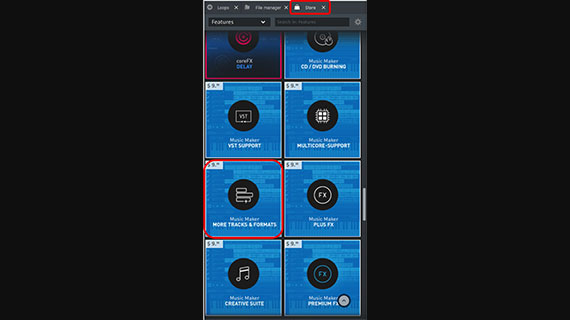
Installing the add-on module "More tracks and formats"
In order to edit MP3 files, they must first be converted back into "normal" audio files. For that, you'll need the add-on pack "More tracks and formats" or a Music Maker Edition such as MUSIC MAKER Premium. Both can be purchased and activated directly in the program's in-app Store. To get this add-on, proceed as follows:·
- Open the "Store" in the top right.
- Select the "Features" option from the dropdown menu.
- Search for "More tracks and formats" or scroll through the list of items until you find the corresponding tile.
- Click on the "More tracks and formats" tile to read more detailed information.
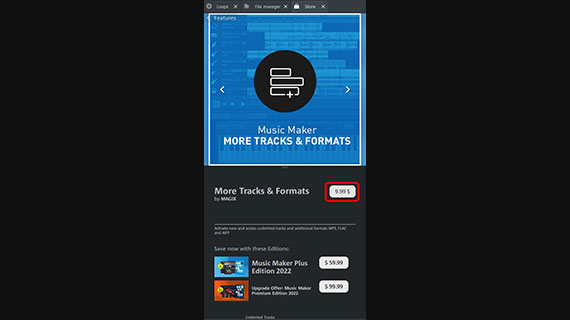
- Click on the price to to buy the add-on and follow the instructions.
This will provide you with unlimited access to both MP3 and FLAC formats. Now, you can load and edit all MP3 files, as well as create them from other audio formats. Additionally, you now have an unlimited number of tracks in the project window.
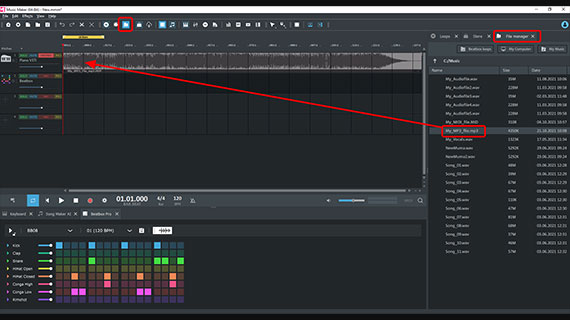
Importing and playing MP3 files
To import an MP3 file, proceed as follows:
- Click the icon for the File manager in the upper toolbar. This will open the File manager on the right.
- Browse in the File manager to the folder where your MP3 files are saved.
- Drag the MP3 file to the left into the arranger by holding down the left mouse button (drag & drop).
- If required, zoom in using the zoom buttons in the lower right so that you can see all the media in the arranger.
You can drag the MP3 files anywhere onto any track. In general, it makes the most sense to drag the MP3 file directly to the beginning of track 1.
- The easiest way to play and pause playback is by pressing the spacebar.
- Click in the timeline to move the playback marker. This allows you to jump to different position.
To combine multiple files in one project, drag them individually from the File manager onto different tracks.
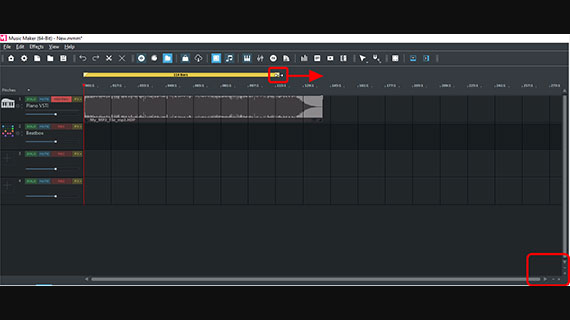
Playback always occurs within the yellow range above the top track.
- To change the range, drag the ends to the left or right with the mouse. You can also move the ends with a simple click in the range bar: Left-clicking sets the start of the range, right-clicking sets the end of the range.
- The yellow playback range can also be shifted freely. To do this, click in the middle of the area and drag the range to the left or right over another part of the project, for example over another MP3 file in the timeline.
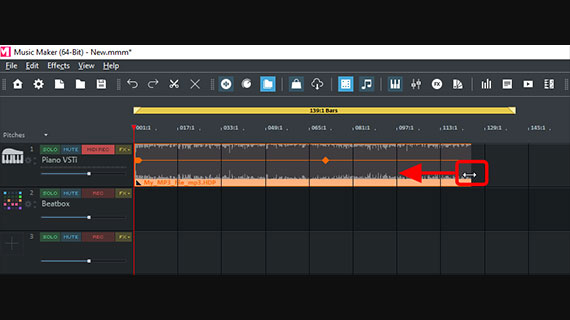
Editing MP3 files and adding fade-ins and fade-outs
All MP3 files in the project can be edited easily using the same method:
- Move the mouse pointer to the front or back edge of the object until the mouse pointer becomes a double arrow. Now, you can click and drag the object border inward.
This will shorten the object. This allows you to cut out unnecessary parts at the beginning and end.
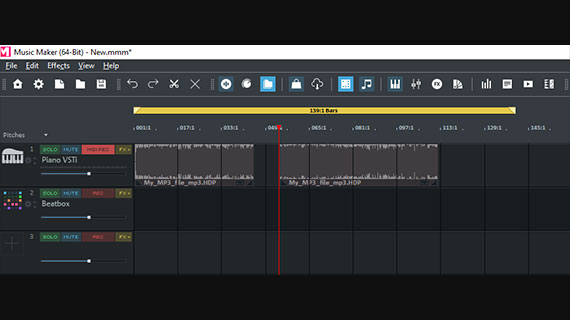
- To cut an MP3 file in the middle, place the playback marker at the desired position for the cut and press the "T" key.
This cuts the object in the track into two separate objects. To delete a certain section, cut the file once at the front and again at the back of the passage and then simply delete the unnecessary part(s) with the Del key.
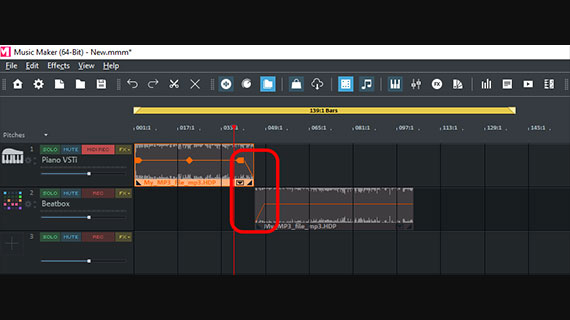
You can fade two objects into each other by applying a crossfade:
- Move the rear object onto its own track below and drag it forward so that the start overlaps with the end of the first MP3 file.
- Click the object above to select it.
Now, handles will appear on the object.
- Drag the handle at the back object edge to the left. This will create a fade-out.
- Click the bottom object and drag its front handle to the right. This will create a fade-in.
Alternatively, you can merge the two files on the same track. This will create a crossfade. However, it is possible to adjust the crossfade more precisely if the two files are placed on two different tracks.
- Play the transition and listen to the result. If necessary, adjust the position of the files on the tracks and the fade handles until the desired result is achieved.
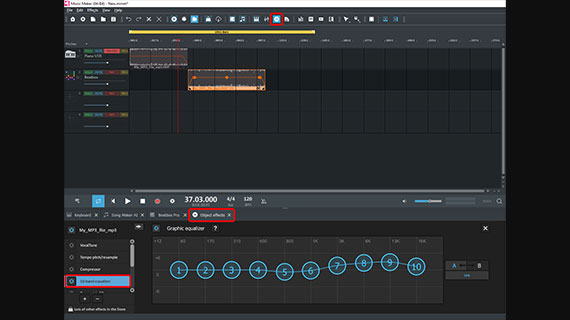
Editing the sound of MP3 files
Perhaps your MP3 could use some enhancement to its audio?
- Click on the FX button in the upper toolbar to open the Object effects
The object effects will appear in the lower area. They always apply to the corresponding selected object in the track. You can use the equalizer to give dull recordings a little more brightness and transparency. Use the compressor to increase loudness and punch.
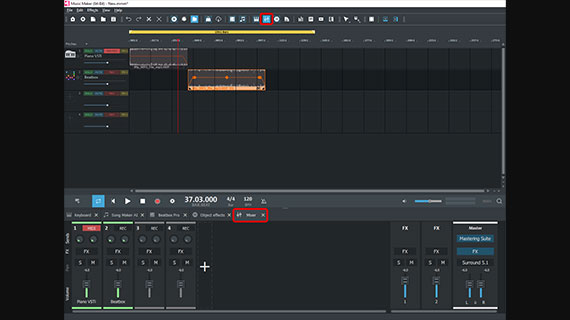
- Use the mixer to balance the volume of files on different tracks, which can be accessed by pressing the "M" key or the mixer icon in the toolbar.
This is where to find additional track effects for every objects in a track and the mastering section for the overall sound as well.
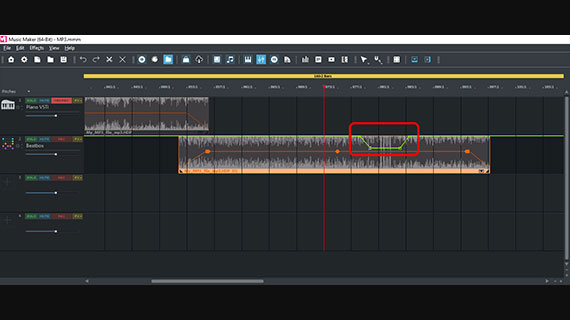
Adjusting the volume of MP3 files
In some cases, you may want to reduce or increase the volume of certain parts of an MP3 file. This can be done using a volume curve.
- Right-click on an empty area and select "Display track curves" > "Volume".
- Zoom into the display if necessary and place curve handles by double-clicking on the volume curve.
- Drag the automation curve down using the curve handles.
To make a specified range louder, do the opposite and make all the other ranges quieter using the volume curve. This helps prevent clipping.
The mixer also provides control over the overall volume of individual tracks. This lets you achieve a harmonious volume balance across several objects in the arranger.
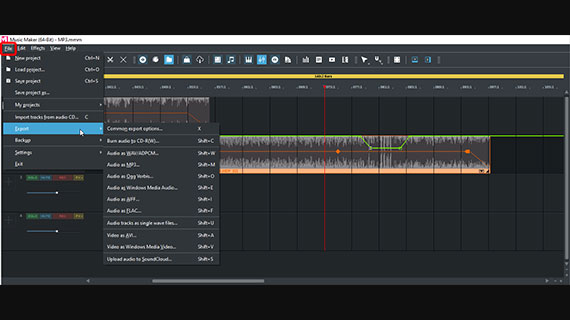
Exporting MP3 files
When you are satisfied with the editing, sound and volume levels of your MP3 files, you need to export your project. You have the choice to export the entire project from beginning to end, or just the current playback range. If you only want to export a specific area, make sure that the playback range is exactly over the desired portion of the project.
To export, open the "File" menu and select an option from the "Export" submenu. The following audio formats are available for compressing files:
- Audio as MP3: This option creates MP3 files again, which contain all the cuts and editing made in the project.
- Audio as Ogg Vorbis: OGG is also common and has (almost) the same properties as MP3. The main advantage of this format is that it is available for free. That means this option is also available for use without the additional package "More tracks and formats".
- Audio as Windows Media Audio: WMA files are also free, this codec was developed by Microsoft and is included with your Windows operating system.
- Audio as FLAC: This format is the only, true lossless compression format (aside from WAV). This means it offers the highest sound quality. Even formats with quality loss, like MP3 and OGG, settings can be adjusted so that you don't notice any quality loss or artifacts in the sound. Like MP3, FLAC requires the purchase of the "More Tracks and Formats" add-on pack or a Music Maker Edition.
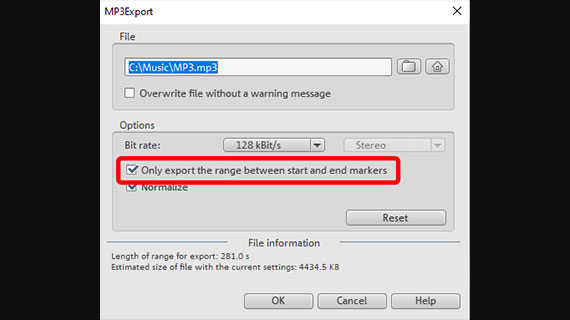
No matter the case, there is an export dialog where you can change the compression settings, i.e. increase or decrease the amount of compression.
- If you only want to export the current playback range instead of the complete project, be sure to select the "Only export the area between the start and end markers" option in the export dialog.
- Click "OK" and select a target directory where you want to save your files. This is where you will find your compressed files and then copy them to your smartphone, for example.















